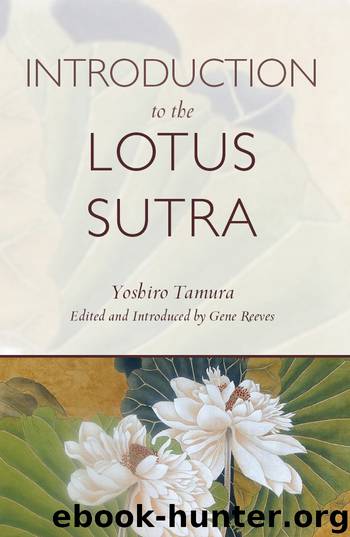Introduction to the Lotus Sutra by Yoshiro Tamura

Author:Yoshiro Tamura
Language: eng
Format: epub, azw3
Publisher: Wisdom Publications
Good, good, if you can protect those who receive and keep even the name of the Dharma Flower Sutra, your blessings will be immeasurable.184
People have often recited passages such as these. These phrases, the dharani, and Mother of Demons were all used to promote a kind of faith that is beneficial for combating calamity and inviting good fortune in this world.
Chapter 27 tells a story about two princes who converted their father, a non-Buddhist king, to faith in the Lotus Sutra. These words are often quoted from it:
A buddha is as difficult to meet as an udumbara flower, or as a one-eyed tortoise meeting the hole in a floating log.185
Chapter 28 teaches the four kinds of normative conduct appropriate to the Lotus Sutra: securing the protection of the Buddha, planting roots of goodness, joining a good congregation, and resolving to save all beings. It then teaches in various ways the protection of followers of the Lotus Sutra through the grace of the Bodhisattva Universal Sage (Samantabhadra), which in turn became Universal Sage’s vow to practice the faith.
The Lotus Sutra itself comes to an end here. Yet the Sutra of Contemplation of the Dharma Practice of Universal Sage Bodhisattva186 (which is in line with chapter 28 of the Lotus Sutra) immediately follows, and has been taken as the concluding sutra of the Lotus Sutra, just as the Sutra of Innumerable Meanings (in line with on the “innumerable meanings” found in chapter 1) was placed at the beginning of the Lotus Sutra and regarded as its opening sutra. The three sutras taken together are called “The Threefold Lotus Sutra.” The Contemplation of Universal Sage Sutra emphasizes the vow of Universal Sage to practice the faith, or the repentance part of his meditation on practice. The theory of reality repentance187 found in this sutra especially has received much attention.
Reality repentance is the teaching that:
The whole ocean of hindrances from past actions
Arises from illusion.
If you want to repent, you should sit upright
And reflect on the true nature of things.
All sins are like frost and dew.
The sun of wisdom can dissipate them.188
Here the key point has to do with meditation on emptiness. In other words,
What is sin? What is virtue? As the thought of self is itself empty, neither sin nor virtue is our master.189
It recommends that:
You should recite the Great Vehicle
And meditate on the emptiness and formlessness of things. . .190
The sutra itself calls this “repentance without sin.”191
This “repentance without sin” was later misunderstood to mean that there is neither sin nor evil. But originally it was based on being captivated by sin or evil, and it advocates getting rid of such captivation through meditation on emptiness. Tiantai Zhiyi created the Lotus samadhi or meditation on the basis of this reality repentance.
Download
Introduction to the Lotus Sutra by Yoshiro Tamura.azw3
This site does not store any files on its server. We only index and link to content provided by other sites. Please contact the content providers to delete copyright contents if any and email us, we'll remove relevant links or contents immediately.
| Buddhism | Christianity |
| Ethnic & Tribal | General |
| Hinduism | Islam |
| Judaism | New Age, Mythology & Occult |
| Religion, Politics & State |
Cecilia; Or, Memoirs of an Heiress — Volume 1 by Fanny Burney(31341)
Cecilia; Or, Memoirs of an Heiress — Volume 3 by Fanny Burney(30938)
Cecilia; Or, Memoirs of an Heiress — Volume 2 by Fanny Burney(30897)
The Secret History by Donna Tartt(16644)
Sapiens: A Brief History of Humankind by Yuval Noah Harari(13067)
Leonardo da Vinci by Walter Isaacson(11913)
The Radium Girls by Kate Moore(10914)
Sapiens by Yuval Noah Harari(4546)
The Wind in My Hair by Masih Alinejad(4427)
How Democracies Die by Steven Levitsky & Daniel Ziblatt(4407)
Homo Deus: A Brief History of Tomorrow by Yuval Noah Harari(4287)
Endurance: Shackleton's Incredible Voyage by Alfred Lansing(3852)
The Silk Roads by Peter Frankopan(3771)
Man's Search for Meaning by Viktor Frankl(3645)
Millionaire: The Philanderer, Gambler, and Duelist Who Invented Modern Finance by Janet Gleeson(3574)
The Rape of Nanking by Iris Chang(3522)
Hitler in Los Angeles by Steven J. Ross(3444)
The Motorcycle Diaries by Ernesto Che Guevara(3341)
Joan of Arc by Mary Gordon(3263)
